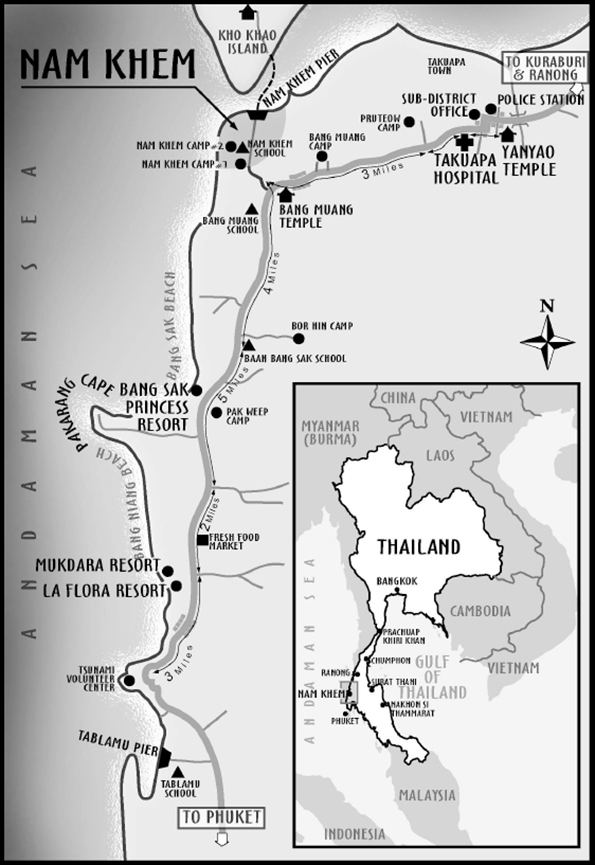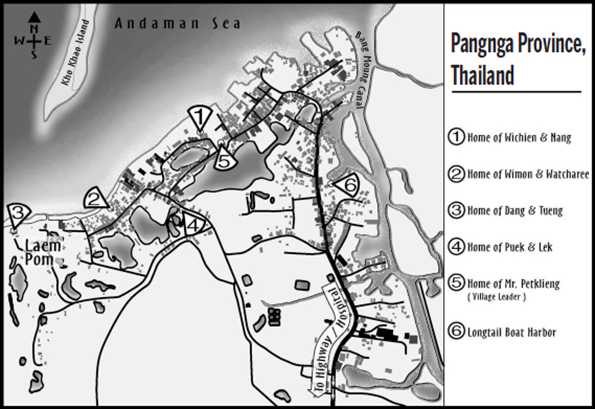


Notice
Mention of specific companies, organizations, or authorities in this book does not imply endorsement by the author or publisher, nor does mention of specific companies, organizations, or authorities imply that they endorse this book, its author, or the publisher.
Internet addresses and telephone numbers given in this book were accurate at the time it went to press.
2006 by Erich Krauss
All rights reserved. No part of this publication may be reproduced or transmitted in any form or by any means, electronic or mechanical, including photocopying, recording, or any other information storage and retrieval system, without the written permission of the publisher.
Illustrations by Erich Krauss Photographs by Sudthida Somsakserm
Book design by Tara Long
Library of Congress Cataloging-in-Publication Data
Krauss, Erich, date.
Wave of destruction : the stories of four families and historys deadliest tsunami / Erich Krauss.
p. cm.
ISBN-13 978-1-59486-378-3 hardcover
ISBN-10 1-59486-378-4 hardcover
eISBN-978-1-62336-378-3 ebook
1. Indian Ocean Tsunami, 2004. 2. TsunamisIndian Ocean. 3. TsunamisThailandNam Keam. 4. Survival after airplane accidents, shipwrecks, etc. I. Title.
GC222.I45K73 2006

We inspire and enable people to improve their lives and the world around them
For more of our products visit rodalestore.com or call 800-848-4735
To the villagers of Nam Khem

CONTENTS
ACKNOWLEDGMENTS
A very special thanks to Sudthida Nui Somsakserm for devoting all her time and energy to helping survivors, and for contributing to this book in every way possible. For their editing, support, and selfless contributions to tsunami victims, I would like to thank Brooke Motta, Glen Cordoza, and Leland Ratcliff. I would also like to thank Frank Scatoni and Greg Dinkin, my two wonderful agents and friends, for helping me every step of the way. And finally, I cannot express enough gratitude to Pete Fornatale, my editor at Rodale, for steering me in the right direction at the beginning of my career, and now, many years later, for embracing this book, pulling it close to his heart, and offering exceptional guidance in the telling of this tragic event.
PROLOGUE
In the middle of the last century, a hundred men cleared a patch of jungle on the west coast of Thailands Isthmus of Kra so that tin mines could be dug into the earth and huts could be built by their side for the laborers who would mine them. The village that sprung to life overnight had no original people, and as a consequence, it attracted two typesthose who were desperate, and those filled with greed. The latter came in the form of hit men and ex-convicts and tin-mining bosses. The bosses used the hit men and ex-convicts to settle violent disputes with other mining bosses over the rights to the various mining areas. The bosses who triumphed made money hand over fist and built casinos and saloons and brothels that filled with prostitutes brought in by the truckload. Every morning, the bodies of men whod been on the receiving end of the previous nights gunplay were placed into sawngthaews and carted up the long, windy road that connected the village of Nam Khem to the dirt highway and the rest of the country. Farmers and fishermen and even the police who lived and worked in the general vicinity ignored the village and closed their ears to the rumors of what went on there, but others didnt have such luxury. The desperate rolled in.
Sixteen-year-old Thana Phondaecha, a clean-living country boy who had eleven brothers and sisters to support, came in the summer of 1972. He planned to work a year and then leave the village in his past, but nine years later he married nineteen-year-old Suphee Namlakorn, who had come to live with her uncle and to discover if the sea was truly made from salt, as shed heard. Wiroj Ruamwong arrived at seventeen to fish the waters of the Andaman Sea. During his second trip out, he got shot at by soldiers on a Burmese patrol boat and ran home to become a monk, before returning in 1983 with better street smarts and the intention of making a fortune. His wife, Loogin, followed him a year later, while lugging their baby on her back, to keep her husband out of the brothels and living straight. Wimon Thongtae had lived on the Gulf of Thailand side of the isthmus until he lost his home and all his possessions piece by piece to three massive floods. He arrived in 1977 and sold dried fruit to tin miners, eager to find a place where he could start life anew. Ratree Kongwatmai, born on the soft soil of a hut in the southern portion of the village in 1975, was the daughter of an out-of-work rubber tree tapper who had come to avoid starvation.
Each of these four families survived the ruthless years of the tin-mining boom while many others did not. They survived the five massive fires that swept through Nam Khem and claimed hundreds of homes and numerous lives. They survived when Southeast Asia fell into a massive recession, and years later they survived when the tin dried up altogether. The village to which they had come out of desperation to make their last stand had become their home. The wealth in the soil might have gone fallow, but the sea still held riches. They turned to fishing and diving for pearls and sailing into foreign waters to pilfer lobster. They opened small bistros and portable restaurants, which they carried up and down the villages muddy streets in sidecars attached to their motorbikes. They worked as day laborers and helped build massive hotel/resorts far south, on the island of Phuket; and when tourism spilled over to the mainland, they helped build the massive hotel/resorts all the way up to their backyard. Then a mining company claimed to own all the land on which they lived, and tried to sell it to money barons who wanted to build a hotel/resort in Nam Khem. They marched to the district hall in a mob that turned violent, and they survived that as well, and many walked away with deeds to their homes.
After thirty years of struggle and strife, each of these four families considered themselves original people from Nam Khem. They had made and lost fortunes on this patch of soil nestled between the jungle and the Andaman Sea. They had birthed and buried loved ones. They had put the violence behind them and looked ahead to nothing more than a simple life surrounded by family, palm trees, and a gentle breeze. Submersed in their daily routine, none of them saw the tsunami coming until it crashed down on their lives. It claimed more than they ever thought they had to give, and it thrust them headlong into the greatest battle theyd ever known. They werent among the quarter of a million people who perished that day, but none of them truly made it out alive. Their lives tell the story of Nam Khem, one of a hundred coastal villages from Indonesia to India that got swept from the earth in the blink of an eye on the morning of December 26, 2004.
Next page














